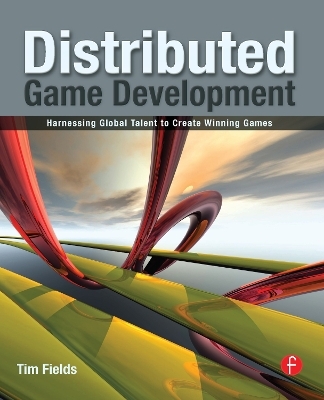
Distributed Game Development
Focal Press (Verlag)
978-0-240-81271-7 (ISBN)
Take control of your global game development team and make successful AAA game titles using the 'Distributed Development' model. Game industry veteran Tim Fields teaches you how to evaluate game deals, how to staff teams for highly distributed game development, and how to maintain challenging relationships in order to get great games to market. This book is filled with interviews with a broad spectrum of industry experts from top game publishers and business owners in the US and UK. A supplementary web site provides interviews from the book, a forum where developers and publishers can connect, and additional tips and tricks. Topics include:
Tim Fields has been in the game industry since 1995 as a producer, project manager, design lead, and business developer. Tim has helped small studios and top publishers like EA and Microsoft run teams that create great games. He has worked on shooters, sports games, racing titles, and RPGs using talent and teams from North America, Asia, Europe, and the UK.
Distributed Game Development
Introduction
i. Overview
ii. Who is this document for?
Preamble on Distributed Development
i. Why would you have distributed development?
ii. Who we will meet in our case studies, and why we care about what they have to say.
Chapter 1: Organizing Your Teams
i. Types of Distributed Collaboration: How to Know what you need
ii. How to pick external collaborators
a. INTERVIEW: Fay Griffith - Head of outsourcing and external development, Electronic Arts. On How to Select Partners
iii. How to pick an external team
iv. Insourcing
v. Roles & Responsibilities
a. INTERVIEW: Sergio Rosas - Studio Head CGBot, Monterrey Mexico. On Tailoring Creation Teams for Different Clients
vi. Subcontractors
vii. Quality Assurance
viii. Localization
ix. Infrastructure
x. The contract and other legal issues
xi. Failure Study: When the Organization phase went wrong.
Chapter 2: Getting off on the right foot
i. Defining project parameters
1. Scheduling Goals, Techniques, Milestones
ii. Make sure you have a shared vision.
a. INTERVIEW: Bill Byrne - Freelance Motion Graphics Editor. Setting project tone through visuals.
iii. Kickoff Meetings
iv. Scheduling Types & Tactics
1. SCRUM/AGILE vs. WATERFALL
a. INTERVIEW: Everett Lee - Producer, Sony Entertainment. ?How to lead great teams through more agile planning.
v. Failure Study: When the schedule is wrong.
vi. Failure Study: When your vision is clouded.
Chapter 3: Maintaining the organism
i. Establishing & Maintaining Trust
a. INTERVIEW: Kyle Clark - VP Production, ReelFX. Delivering content to spec for motion pictures & television.
ii. Progress Checkpoints
iii. Milestones
iv. How to deal with product goal or design changes
a. INTERVIEW: Rhett Bennatt - Project Manager, Aspyre Entertainment. Nimble projects for maximum profits.
v. Cross Pollination
vi. Finaling and product submission
vii. Planning for your next date
viii. Failure Study: Feature Creep and the carnival of design changes.
Chapter 4: Site Visits
i. Site visits
ii. Who to send & why
iii. When to go?
a. INTERVIEW: Michael Wyman - Founder, Big Splash Entertainment. Distributed development for Casual Games.
iv. Representing your company and the project while on site.
v. Communication
vi. Language barriers
vii. Dealing with distractions
viii. Cultural Differences
a. INTERVIEW: Frank Klier - Senior Technical Director, Microsoft. Coordinating technical solutions across cultural boundaries.
ix. Regional Conditions
x. Helpful Tools for staying in touch with home base
xi. Failure Study: What happens when communication between home base and the field goes awry.
Chapter 5: Common Situations
i. Hot Potato Projects
a. INTERVIEW: Mark Greenshields - President, Firebrand Games. Delivering quality products on time.
ii. Crisis Management
iii. The constantly moving target
iv. Bug Counts / Defect management
v. Localization
vi. Central Content Teams
vii. Central Tech Groups
viii. Sense of Urgency
a. INTERVIEW: Dave Hawkins - Managing Director, Exient LTD. How to select projects for your development team.
ix. Failure Case: When the bugs eat you.
Conclusions:
i. Wrapping it up
ii. What the future holds
iii. Where to get more information
iv. Helpful templates
| Erscheint lt. Verlag | 16.4.2010 |
|---|---|
| Zusatzinfo | 30 Halftones, black and white |
| Verlagsort | Oxford |
| Sprache | englisch |
| Maße | 191 x 235 mm |
| Gewicht | 521 g |
| Themenwelt | Kunst / Musik / Theater |
| Mathematik / Informatik ► Informatik ► Grafik / Design | |
| Informatik ► Software Entwicklung ► Spieleprogrammierung | |
| ISBN-10 | 0-240-81271-9 / 0240812719 |
| ISBN-13 | 978-0-240-81271-7 / 9780240812717 |
| Zustand | Neuware |
| Haben Sie eine Frage zum Produkt? |
aus dem Bereich


